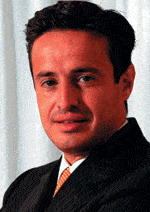Latin American Corporate Finance Teams Get Ready to Round Up Some Deals
Corporate financing in Latin America is about to make a comeback, as deals that make strategic sense cant be put off any longer, bankers say.

Paul Knight, co-head of Latin American investment banking at UBS, says the climate for raising capital in Brazil is as different as day and night from a year ago. The cost of funds is coming down for investment-grade Brazilian banks tapping the US dollar-denominated long-term capital markets, he says.
The signs of a turnaround in Argentina are not as obvious, Knight notes, but the country is beginning to show some economic growth, and there is rational talk of restructuring the sovereign debt. The M&A; market in Latin America is not what the headlines suggest, he says. Investors are eager to acquire assets at attractive levels, he continues, and the investment climate has improved considerably in recent months.
UBS was granted the sell-side mandate for Brazilian paper and pulp producer Klabin, which announced a preliminary deal on June 2, 2003, for the sale of its Riocell unit to rival Aracruz Celulose. The valuation obtained by our client was above expectations, as a number of foreign and local buyers competed aggressively to buy Riocell, Knight says.
Investors had been expecting Klabin to sell Riocell, a eucalyptus kraft pulp producer, for about $500 million, but the sale price was $610.5 million. Nicolaas Millward, head of Latin American equity capital markets at UBS, says, Nobody believed the upturn in Brazil would be so rapid and dramatic.
Equity Issuance Drought To End
The drought in new equity issuance will come to an end in the second half of 2003, Millward says, with a number of issues likely to come to market.
Petrobras, Brazils state-controlled oil producer, plans to sell $2 billion of stock to help finance a four-year expansion, CEO Jose Dutra told the Brazilian senate in June. The timing of the sale will depend on market conditions.
Brazil returned to the international debt markets in April 2003 with a $1 billion sovereign bond issue managed by Merrill Lynch and UBS. The global issue was the countrys first in more than a year and was increased from $750 million due to strong demand.
On May 6, 2003, Mexico-based Coca-Cola Femsa closed a $3.65 billion purchase of Panamerican Beverages, or Panamco, creating the biggest bottler of Coca-Cola products in Latin America and the second largest in the world. Coca-Cola Femsa said the deal would be partly financed with $2.05 billion of new debt.
This is a landmark event for the region, says Stephen Cunningham, a managing director at Morgan Stanley responsible for Latin American investment banking. The Coca-Cola Femsa/Panamco transaction is the largest acquisition by a Mexican company. It is also the largest merger of two New York Stock Exchange-listed Latin American companies, Cunningham says.
Panamco makes and distributes Coca-Cola products in Mexico, Brazil, Colombia, Venezuela, Costa Rica, Guatemala, Nicaragua and Panama. It also produces bottled water and distributes beer and other beverages. Morgan Stanley represented Coca-Cola Femsa on the transaction and provided the company with a substantial bank loan. JPMorgan advised the seller.
Foreign Banks Play a Major Role
Spanish and Portuguese banks also are playing important roles in Latin American corporate financing and have climbed to the top of regional league tables.
Lisbon-based Banco Espirito Santo was the leading financial adviser for mergers and acquisitions announced in Latin America in the first quarter of 2003, with three deals totaling $1.9 billion, according to Thomson Financial.
The Portuguese bank advised Brazils Banco Bradesco on its $812 million acquisition of the Brazilian unit of Banco Bilbao Vizcaya Argentaria, the largest M&A; deal in Brazil in the first quarter. Banco Espirito Santo and Bradesco are partners in BES Investimento, a Latin American investment bank in which the Portuguese institution owns 80% of the share capital.
BBVA and Santander Central Hispano, Spains two largest banks, have extensive networks in Latin America and are active in regional investment banking. Although the political and economic situation has been very unsettled in the recent past, Latin America is recovering, says Javier Maldonado Trinchant, a managing director and global head of corporate finance at Santander Central Hispano.
This is reflected in Latin American stock markets, Maldonado says. From January 1 through mid-June of this year, the So Paulo Stock Exchanges benchmark Bovespa index rose 50% in US dollar terms and 25% in local currency. Argentinas Merval index spurted 70% in dollars in the same period, setting a five-year high. We are always positive about investing in Latin America, because we know the region, Maldonado says. Investment opportunities are even more attractive following the downturn in prices during the recent crisis, he continues.
Santander Central Hispano is a major shareholder in a dozen Latin American banks and a minority shareholder in Argentinas Banco Galicia. In March 2003 Bank of America closed on an agreement to acquire a 24.9% interest in Santander Serfin, the third-largest bank in Mexico.
Santander Central Hispano Investment Securities acted as exclusive adviser to Colombias state transmission company ISA, which signed contracts in September 2002 for a 30-year concession to operate two Peruvian electricity transmission companies, Etecen and Etesur. ISA paid the Peruvian government $262 million for the two concessions in what was the largest privatization in Peru last year.
SCHI also advised on the merger of Santander-owned banks Banco Santander-Chile and Banco Santiago last year to form Chiles largest financial institution. This merger created Banco Santander Santiago, with two million customers and 350 branches.
Among equity issues in 2002, SCHI was a global coordinator of a $240 million offering by Brazils Sabesp, the largest water and sewage utility in the Americas. SCHI was structuring agent on a number of Latin American debt offerings this year, including an $87 million bond issue for Chilean toll-road operator Autopista Los Libertadores.
Spains BBVA is building a regional operations center for the Americas in Mexico, where it controls BBVA Bancomer with a 54.5% stake. BBVA Bancomer was the top underwriter of debt in Latin American domestic markets in the first quarter of 2003, according to Thomson Financial. The bank is a leading bookrunner for certificados bursatiles, which are exchange-traded peso-denominated instruments introduced by Mexico in 1991 to help create a long-term local debt market. Mexican companies often use swap agreements to convert their peso borrowings under the program into US dollars to match their revenue streams.
Debt Financing on the Rise

|
|
|
There will also be a pickup in M&A; activity focused on major regional players as well as multinationals, Cunningham says.
Probably by the end of the third quarter of 2003, and definitely by the fourth quarter, there will be a substantial increase in equity offerings in Latin America involving both convertibles and straight common, he predicts.
By way of example, Cunningham points to a complex deal in the Brazilian mining industry announced this year, in which Morgan Stanley advised Mitsui, Japans second-biggest trading company. At the end of March, Brazils Companhia Vale do Rio Doce, or CVRD, the worlds largest iron ore producer, reached an agreement with Mitsui to acquire all of the Japanese companys common and preferred shares in Caemi, another major Brazilian iron ore producer, for $426.4 million. The deal gives CVRD ownership of all of Caemis ordinary shares, since it previously owned 50%. It also gives CVRD 40% of Caemis preferred stock and 60% of its total capital.

|
|
|
In times of trouble for the region, financial institutions tend to pull back, but our approach is different, says Nicolas Aguzin, managing director and head of Latin America M&A; at JPMorgan. Since the 1800s, when we first became involved with companies in Latin America, we have been there through good times and bad times, he says. In the tough times, we improve our position significantly. Its easier when there are not 10 banks standing in line.
The fact that a majority of the mergers in Latin America this year have been among companies within the region has been a plus for JPMorgan, according to Aguzin. Latin-to-Latin deals are an area of significant strength to us, he says.

|
|
|
As the Latin American capital markets develop and mature, long-term players in the region are beginning to reap the benefits of having stood by their clients during the lean years.
While some investment banks continue to announce substantial layoffs, Latin American teams are usually escaping the knife. In fact, some banks say they plan to selectively increase their coverage in what is becoming a hot area.
Gordon Platt



